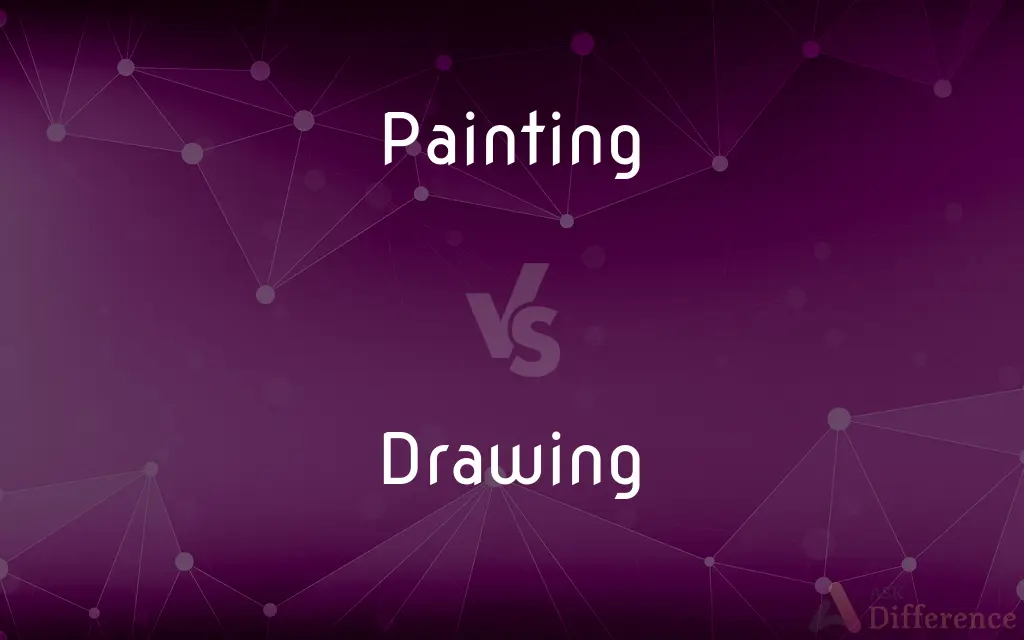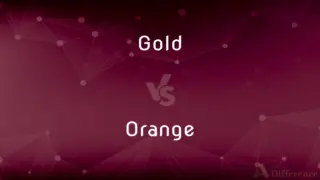Painting vs. Drawing — What's the Difference?
By Tayyaba Rehman & Maham Liaqat — Updated on April 17, 2024
Painting involves applying color with tools like brushes on surfaces such as canvas, emphasizing textures and blends; drawing focuses on creating images using lines and shades, primarily with pencils or pens.

Difference Between Painting and Drawing
Table of Contents
ADVERTISEMENT
Key Differences
Painting typically uses a variety of tools like brushes, rollers, or knives to apply pigments in liquid form, such as oil, acrylic, or watercolor, to surfaces such as canvas, paper, or walls. On the other hand, drawing primarily involves the use of pencils, pens, markers, or charcoals to create images, relying on line and shade rather than color.
In painting, the emphasis often lies in the layering of colors, the creation of texture, and the blending of hues to achieve depth and vibrancy. Whereas in drawing, the focus is generally on precision of lines, the clarity of contours, and the use of shading to suggest three-dimensionality.
Artists choose painting to express complex themes with a rich palette and a dynamic range of textures and effects. Conversely, drawing is favored for its simplicity and directness, offering a more immediate form of artistic expression that can be both highly detailed and strikingly minimalist.
Paintings can take longer to complete due to the need for layers of paint to dry, and they are often more material-intensive. In contrast, drawings can be quickly executed and require fewer materials, making them more accessible and convenient for both amateur and professional artists.
The learning curve for painting can be steep, as it involves mastering various techniques and understanding the properties of different paints and mediums. Drawing, while also requiring skill and practice, is often perceived as more straightforward to learn, focusing on hand-eye coordination and the ability to use lines effectively.
ADVERTISEMENT
Comparison Chart
Mediums Used
Oils, acrylics, watercolors
Pencils, pens, charcoal, markers
Tools
Brushes, knives, rollers
Pencils, styluses, charcoal sticks
Surface
Canvas, paper, walls
Paper, card, tablets
Techniques
Blending, glazing, texturing
Sketching, shading, stippling
Expression Form
Colorful, textured, and layered
Line-based, monochrome, detail-oriented
Compare with Definitions
Painting
A process of applying color to a surface using various tools.
She spent the afternoon painting a landscape on a large canvas.
Drawing
The technique of producing images on a surface, usually paper, by means of marks, usually of ink, graphite, or chalk.
Drawing requires a steady hand and a good eye for detail.
Painting
An artwork created through the application of paints.
His painting was exhibited at the local gallery.
Drawing
The act of making marks on a surface with a pen, pencil, or other tool.
She was drawing a portrait with a simple graphite pencil.
Painting
The action or skill of using paint, either in a picture or as decoration.
Painting requires patience, especially when you're mixing colors.
Drawing
A picture or diagram made with a pencil, pen, or crayon rather than paint.
He framed the drawing his son made in art class.
Painting
A depiction or representation in paint.
The painting captured the light of the sunset beautifully.
Drawing
A form of visual art that makes use of any number of drawing instruments.
Her drawing skills have improved dramatically over the years.
Painting
The practice of covering surfaces with paint as a form of artistic expression.
Painting the mural took them over a month.
Drawing
The selection or drawing of names or numbers in a lottery.
The drawing of lottery numbers is at 7 PM every Friday.
Painting
Painting is the practice of applying paint, pigment, color or other medium to a solid surface (called the "matrix" or "support"). The medium is commonly applied to the base with a brush, but other implements, such as knives, sponges, and airbrushes, can be used.
Drawing
Drawing is a form of visual art in which an artist uses instruments to mark paper or other two-dimensional surface. Drawing instruments include graphite pencils, pen and ink, various kinds of paints, inked brushes, colored pencils, crayons, charcoal, chalk, pastels, erasers, markers, styluses, and metals (such as silverpoint).
Painting
The process, art, or occupation of coating surfaces with paint for a utilitarian or artistic effect.
Drawing
The act or an instance of drawing.
Painting
A picture or design in paint.
Drawing
The art of representing objects or forms on a surface chiefly by means of lines.
Painting
Present participle of paint
Drawing
A work produced by this art.
Painting
(countable) An illustration or artwork done with the use of paint.
The Mona Lisa is one of the most famous paintings.
Drawing
Present participle of draw
Painting
(uncountable) The action of applying paint to a surface.
The outside of the old house would benefit from some painting.
Drawing
A picture, likeness, diagram or representation, usually drawn on paper.
Painting
(uncountable) The same activity as an art form.
Some artists, like Michelangelo, excel in both painting and sculpture.
Drawing
The act of producing such a picture.
Painting
The act or employment of laying on, or adorning with, paints or colors.
Drawing
Such acts practiced as a graphic art form.
Painting
The work of the painter; also, any work of art in which objects are represented in color on a flat surface; a colored representation of any object or scene; a picture.
Drawing
The process of drawing or pulling something.
Proverb: An official is great in his office as a well is rich in drawings of water.
Painting
Color laid on; paint.
Drawing
An act or event in which the outcome (e.g., designating a winner) is selected by chance in the form of a blind draw, notably of lots; especially such a contest in which a winning name or number is selected randomly by removing (or drawing) it from a container, popularly a hat.
Painting
A depicting by words; vivid representation in words.
Drawing
A small portion of tea for steeping.
Painting
Graphic art consisting of an artistic composition made by applying paints to a surface;
A small painting by Picasso
He bought the painting as an investment
His pictures hang in the Louvre
Drawing
The act of pulling, or attracting.
Painting
Creating a picture with paints;
He studied painting and sculpture for many years
Drawing
The act or the art of representing any object by means of lines and shades; especially, such a representation when in one color, or in tints used not to represent the colors of natural objects, but for effect only, and produced with hard material such as pencil, chalk, etc.; delineation; also, the figure or representation drawn.
Painting
The act of applying paint to a surface;
You can finish the job of painting faster with a roller than with a brush
Drawing
The process of stretching or spreading metals as by hammering, or, as in forming wire from rods or tubes and cups from sheet metal, by pulling them through dies.
Painting
The occupation of a house painter;
House painting was the only craft he knew
Drawing
The process of pulling out and elongating the sliver from the carding machine, by revolving rollers, to prepare it for spinning.
Drawing
The distribution of prizes and blanks in a lottery.
Drawing
An illustration that is drawn by hand and published in a book or magazine;
It is shown by the drawing in Fig. 7
Drawing
A representation of forms or objects on a surface by means of lines;
Drawings of abstract forms
He did complicated pen-and-ink drawings like medieval miniatures
Drawing
The creation of artistic drawings;
He learned drawing from his father
Drawing
Players buy (or are given) chances and prizes are distributed according to the drawing of lots
Drawing
Act of getting or draining something such as electricity or a liquid from a source;
The drawing of water from the well
Drawing
The act of moving a load by drawing or pulling
Common Curiosities
Which is considered more accessible for beginners?
Drawing is often considered more accessible and requires fewer materials than painting.
Can drawing include color?
Yes, drawings can include color, but they often prioritize line and form over vibrant color blends.
What are the primary materials used in painting?
Painting often uses liquids like oils, acrylics, or watercolors applied with brushes, knives, or rollers.
What are common surfaces for paintings and drawings?
Paintings are commonly done on canvas or paper, while drawings are typically on paper or card.
What is the main focus of drawing compared to painting?
Drawing focuses on lines, contours, and shading to define forms, while painting emphasizes color and texture.
How do the techniques differ between painting and drawing?
Painting techniques include blending and texturing, whereas drawing involves techniques like sketching and stippling.
Which form is quicker to execute?
Drawing can generally be executed more quickly than painting, which may require waiting for layers to dry.
What role does shading play in drawing?
Shading in drawing is crucial for giving the illusion of depth and three-dimensionality.
Are there hybrid forms that combine painting and drawing?
Yes, many artists integrate both painting and drawing techniques into their works for varied effects.
How do the costs of materials for painting and drawing compare?
Generally, painting materials are costlier and more varied than those needed for drawing, which can be as simple as paper and pencil.
How do artists choose between painting and drawing for a project?
Artists choose based on the desired outcome, material preferences, and the specific demands of the project.
Can digital methods be considered part of painting and drawing?
Yes, digital painting and drawing use software and styluses to mimic traditional techniques on tablets and computers.
What are some historical contexts of painting and drawing?
Both forms have rich histories, with painting and drawing serving as fundamental means of human expression and documentation across cultures.
What are the educational paths for learning painting versus drawing?
Education for both can begin with basic art classes, though specialized courses may focus separately on mastering either skill.
How does the choice of tools affect the artist’s expression?
The choice of tools significantly impacts expression, with painting allowing for broad strokes and texture, while drawing offers precise control over details.
Share Your Discovery

Previous Comparison
Gold vs. Orange
Next Comparison
Salamander vs. NewtAuthor Spotlight
Written by
Tayyaba RehmanTayyaba Rehman is a distinguished writer, currently serving as a primary contributor to askdifference.com. As a researcher in semantics and etymology, Tayyaba's passion for the complexity of languages and their distinctions has found a perfect home on the platform. Tayyaba delves into the intricacies of language, distinguishing between commonly confused words and phrases, thereby providing clarity for readers worldwide.
Co-written by
Maham Liaqat













































